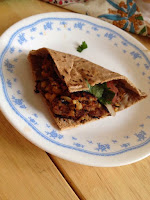How do you deal with exhaustion, nutrition-wise? We discussed this at home a few days ago, because we were both feeling tired from the holiday cooking/hosting/working/playing frenzy. We decided to resort to traditional Chinese nutrition principles, and eat a dish of azuki and mung beans with season greens.
As I explained somewhere else, Chinese medicine analyzes food according to its different properties (cold/warm, dry/moist, yin/yang, expansion/contraction). As with other conditions, exhaustion is a manifestation of an imbalance between the five elements – often, as a weakness in kidney energy. The kidneys, associated with the Chinese element of water, are not only responsible for reproductive functions and related to the bladder, but also govern our storage of life energy. When the kidneys are depleted, we have to build them.
Some types of beans are closely associated with the kidneys: remarkably, azuki or aduki beans and mung or mash beans. The fun thing about these small beans is their remarkable resemblance to each other in everything except color: mung beans are green, and azuki beans are deep rich burgundy, but both are small, egg-shaped, and have a little white spot.
There are many great ways to eat azuki and mung beans. This dish takes them down the spicy Middle Eastern route and mixes them with leafy greens. We ate this for dinner, and felt quite heavy later, so you may want to consider eating this for lunch.
Beans and Greens
1 cup azuki beans
1 cup mung beans
2 cups water or vegetable broth, or mix
1 tbsp olive oil
3 heaping tablespoons cumin
1 tbsp nutmeg
3 tablespoons good quality tomato paste
3 garlic cloves
1 large onion
2 dried small chilis
10 large leaves of red or white beet (in Israel, the easiest is manguld).
Place azukis and mungs in a bowl of water for a few hours. If you have no time, place them in boiling water for twenty minutes. Discard the water.
In a large wok, heat up some olive oil. Chop thinly garlic and onion and add to wok. As you fry up, add the cumin and nutmeg and mix. Make an incision in each of the chilis and add them, too. When everything is mixed and the room becomes fragrant, add the strained beans and fry for a few minutes. Then, add the water or broth and the tomato sauce, lower the heat and let cook for about 30 minutes.
Try eating the beans. Have they gone softer? If they are soft, chop up the greens and layer them on top of the beans; cover again. Cook until the beans are soft. You may have to add water as you go.
You’ll have to take my word that this comes out very pretty because of the contrast in color between the azuki and the mung. We have just a little leftover, but the camera has disappeared. I hope to find it by the next time we cook, which will probably be in the not-so-distant-future!





